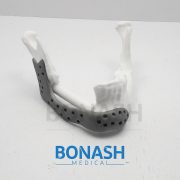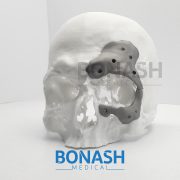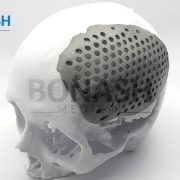Custom made titanium implant
Reconstruction of complex mandibular defects using integrated dental custom-made titanium implants
A.Rachmiel, D.Shiloa, O.Blanca, O.Emodia,
British Journal of Oral and Maxillofacial Surgery.
Reconstruction of the craniofacial complex is challenging because of the unique anatomy, the presence of vital structures and the diversity of defects. In craniofacial reconstruction, restoration of appearance and function is the primary goal. Autografts are the gold standard treatment, but they have several disadvantages, which has led to research into alloplastic materials. The development of CAD/CAM systems allows for precise preoperative planning and design of patient specific implants. In this process, two dimensional DICOM files were converted into 3-dimensional stereolithography files (STL) and the custom made titanium implant was designed using 3-dimensional software.
The skull and custom made titanium implant were printed as an STL model in resin for compatibility. The titanium implant was then printed using a laser sintering 3-dimensional printer.
We present the case of a patient who had his facial bones reconstructed because of a large deficiency in the ramus, body, and angle of his right mandible caused by an ameloblastoma.
Please note:
This abstract was published on Bonash Medical’s website since its content was related to the company’s products. There is no relation between Bonash Medical and the authors. To have full access to the article, please refer to relevant reference.



